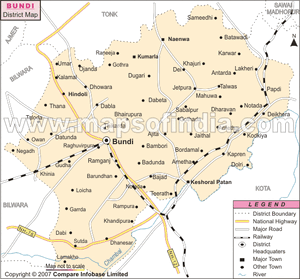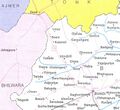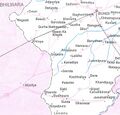Bundi
| Author:Laxman Burdak, IFS (R) |

Bundi (बूंदी) is a city and district in the Hadoti region of Rajasthan state in northwest India. It is of particular architectural note for its ornate forts, palaces, and stepwell reservoirs known as baoris.
Variants
Tahsils in Bundi district
Villages in Bundi tahsil

Ajeta, Akher, Aktasa, Alkodiya, Alphanagar, Amli, Amthoon, Andher, Anoppura, Anthara, Astoli, Badoonda, Bagda, Bagli, Bahadurpura, Bajar, Bakshpura, Balapura, Balapura, Baldeopura, Baldeopura, Ballop, Bambori, Banka Khera, Banki, Baori Khera, Baradhudhalaji, Barfoo, Barkhera, Baroondhan, Barwas, Bathwara, Beebanwa, Beechri, Beelooba, Beodiya, Bhagwanpura @Chainpuriya, Bhairoopura Barad, Bhairoopura Ojha, Bhalsanva, Bhanwarda, Bhanwriya Kua, Bharta Baori, Bhatonka Khera, Bhawani Pura, Bhawani Pura @ Bangamata, Bhawanipura, Bheem Ka Khera, Bheemganj, Bheempura, Bhoomakhera, Bhopat Pura, Bijari, Bijnawar, Binayka, Bisanpura, Budhpura (CT), Bundi (M), Byas Baori, Chanda Ka Talab, Chandanheli, Chapras, Chhant Ka Khera, Chhaparda, Chhapawda, Chhawani, Dabi, Daboosar, Daglawda, Dasalya, Daulat Pura, Dayalpura, Deelunda, Dehit, Deloonda, Deogarh, Deoriya, Dhanatari, Dhaneshwar, Dhola Ki Jhonpariyan, Dhorela, Dolara, Dora, Dulhepura, Ebra, Fatehpura, Gadegal, Gagos, Gamach, Gandhigram, Ganeshpura, Ganeshpura, Ganpatpura, Gardara, Garnara, Gobariya, Gogpura, Golpur, Gopalniwas, Gopalpura, Gopalpura (Barad), Gordhanpura, Gordhanpura, Govindpur Baori, Gulkheri, Gumampura, Gurha, Gurha Nathawatan, Gurhamagdooka, Guwar, Guwari, Hanotya, Hari Pura, Haripura, Haripura @ Jawara Ki Jhopariyan, Hatipura, Hazari Bhiroon Ji Ki Jhopariyan, Holaspura, Itoda, Jakhana, Jakhmoond, Jal Ki Jhonpariyan, Jalera, Jaloda, Jalodi, Jaloti, Jameetpura, Jaoti Kalan, Jaoti Khurd, Jarkhoda, Jawahar Sagar, Jawra, Jharbala Pura, Kachhalya, Kalpuriya, Kalyanpura, Kanan, Kanjri Silor, Kanwarpura, Karad Ka Vardha, Karjoona, Karondi, Kati, Katunara, Kesarpura, Kethooda, Kewariya, Khadipur, Khaloonda, Khankhera, Kharibara, Khatiyari, Khatkar, Kherla, Kheroli, Kheroona, Khunetiya, Khurar, Khyawada, Kishanpura, Kishanpura, Kothiya, Kotkhera, Kumhariya, Kundaliya, Kuwarti, Ladpur, Lakha Ki Jhopariyan, Lalpura, Lamba Peepal, Lambakhoh, Laxmi Pura, Laxmipura, Leelera Byasan, Leelera Charnan, Lohli, Loicha, Mahrampura, Mahrana, Malipura, Mandawara, Mandawari, Manditya, Mandri, Mangal, Mangli, Matoonda, Megharawat Ki Jhonpariyan, Mohanpura, Moheepura, Moti Pura, Motuka, Nainda, Namana, Nanakpuriya, Nandpura, Naroli, Narsingh Pura, Naya Bardha, Nayagaon, Neem Ka Khera, Notara, Onarji Ki Jhonpariyan, Onkarpura, Pakal Puriya, Palka, Parana (Bheelonwala), Parana (Karadonka), Peepalda, Peepalda Hadon Ka, Peeplya, Peetambpura, Prempura, Raghunathpura, Raghunathpura, Raghuveer Pura, Raithal, Rajpura, Rajwas, Ramganj, Ramnagar, Rampuriya (Tulsi), Rampuriya(Dhola), Ratanpura, Rayta, Rihana, Roopnagar, Salriya, Samarba, Sandri, Sangawada, Sankarda, Sanwal Pura, Sapteeja, Sarwan Ki Jhonpariyan, Satheli, Sawar, Sedari, Seelor, Seenta, Seenta, Seenti, Seeta Pura, Shahpura, Shivshakti Ka Khera, Shopuriya Ki Baori, Shrinagar, Shyamoo, Shyopuriya, Sootra, Sundarpura, Suwasan, Talab Bardha, Talera, Teekhabara, Teerath, Teetarwasa, Thari, Theekariya Charnan, Theekariyan Kalan, Tulsi, Ulera, Umarthoona, Umrach,
Early History
Maharaja Kartik was a Jat ruler in Bundi area of Rajasthan. According to Thakur Deshraj, We can presume their rule in the region from fourth to sixth century. [1]
James Tod[2] obtained a Pali language inscription about Jit or Jat tribe at village Ram Chandra Pura (रामचन्द्रपुरा) (Now Chhawni Ram Chandra Pura, 324007 in Kota Municipal area) 3 kos (6 miles) east of Bundi state, while digging a well, which he sent to Asiatic Society London.
The inscription reveals that there was a king Thot (थोत) born in Yuti (यूति) vansha. His son was Raja Chandrasain, a powerful and beloved of his subject. The son of Chandrasain was Kartik, renowned for his prowess. His wife was Gunaniwas, who gave birth to two sons Mukund and Daruk. Daruk had son named Kuhal. Kuhal had son named Dhunak, who achieved great works. He had war with Hill Meenas tribes and defeated and destroyed them. He along with his brother Dok worshipped gods and brahmanas. They founded a Sun-temple for the pleasure of his beloved wife. The temple will stand till the sumer suvarna mountain stands on the sand. Kuhal had founded this temple and a Maheshwar temple in east. The popularity of this was spread by Achal, son of Mahabali Maharaja Yashovarma. [3]
The period of war of this dynasty with pahari Meenas is difficult to asses. If we assume that Jat ruler Kartik had war with Menander then the period of this comes about 150 BC. Menander had attacked areas upto Chittor. It is very likely that Kartik had a war with Menander. This way the period of his descendant becomes the first century. If we look into the period of Achal who made this temple popular it comes around third or fourth century or beyond it, as ruler Yashovarman was in Maukhari vansha in eighth century in Kannauj. He had sent a delegation to China in 731 AD. [4] Lack of records and history prior to sixth century prevents prom determining the exact period of the rule of Kartik and his descendants. According to Thakur Deshraj, We can presume their rule from fourth to sixth century. [5]
Foundation of Bundi
James Tod[6] narrates the history of Hara race, from the regeneration of Anhal, the first Chohan, to the establishment of the first Hara prince in Bundi.
Ishtpal, son of Anuraj ; he was expelled from Asi, S. 1081 (AD 1025), and obtained Asir. He was founder of the Haras ; the chronicle says not how long after obtaining Asi, but evidently very soon.
Rao Hamir, killed in the battle of the Caggar, on the invasion of Shahbudin, S. 1249, or AD. 1193.
Rao Chand, slain in Asir, by Alla-oo-din, in S. 1351, AD 1295.
Rainsi, fled from Asir, and came to Mewar, and in S. 1353 (AD 1297) obtained Bhynsror.
Rao Bango, obtained Bumaoda, Mynal, &c
Rao Dewa, S. 1398 (AD. 1342), took the Bandu valley from the Meenas, founded the city of Bundi, and styled the country Harawati.
James Tod[7] writes that having resigned Bumaoda to Hara-Raj, Rao Dewa came to Bandu-Nal, the spot where his ancestor Colun was cured of disease. Here the Meenas of the Usarda tribe dwelt, under the patriarchal government of Jaita, their chief there was then no regular city ; the extremities of the valley (thal) were closed with barriers of masonry and gates, and the huts of the Meenas were scattered wherever their fancy led them to build.
At his time, the community, which had professed obedience to the Rana on the sack of Chittor, was suffering from the raids of Rao Bango, the Khichi, who from his castle of Ramgarh (Relawan) imposed " birchi-dohae" on all around. To save themselves from Bango, who used " to drive his lance at the barrier of Bandu," the Meenas entered into terms, agreeing, on the full moon of every second month, to suspend the tribute of the chouth over the barrier.
At the appointed time, the Rao came, but no bag of treasure appeared. " Who has been before me ? demanded Gango ; when forth issued the " lord of the Pathar," on the steed coveted by the Lodi king. Gango of Relawun bestrode a charger not less famed than his antagonist's, " which owed his birth to the river-horse of the Par, and a mare of the Khichi chieftain's, as she grazed on its margin. Mounted on this steed, no obstacle could stop him, and even the Chambal was no impediment to his seizing the tribute at all seasons from the Meenas."
The encounter was fierce, but the Hara was victorious, and Gango turned his back on the lord of the Pathar, who tried the mettle of bis son of the Par, pursuing him to the banks of the Chambul What was his surprise, when Gango sprang from the cliff, and horse and rider disappeared in the flood, but soon to re-appear on the opposite bank ! Dewa, who stood amazed, no sooner beheld the Rao emerge, than he exclaimed " Bravo, Rajpoot ! Let me know your name." " Gango Khichi," was the answer. " And mine is Dewa Hara ; we are brothers, and must no longer be enemies. Let the River be our boundary."
It was in S. 1398 (A.D. 1342) that Jaita and the Meenas of Usarra clan acknowledged Rae Dewa the Hara Chauhan as their lord, who erected Bundi in the valley of the Bandu-ca-Nal, which henceforth became the capital of the Haras.
1000 year old fort found

Ref - Rachna Singh,TNN,Apr 20, 2016
About 57 km from Bundi, ruins of a fort have been sighted on the Bundi- Lakheri road in a village called Ulliyana. This adds a leaf of history to this stepwell town of Hada Rajputs. According to archaeologists, the limestone fort is about over 1,000 years old.
Lying dilapidated at the foothills of the Vindhya Range, the fort is hardly noticeable to a passer-by. But a short walk through the mud houses of the village with chattries (the dome-shaped pavilions), takes you to the once-upon-a-time fort, with rubble now scattered all over the foothills. While most of the fort is crumbling, portions of it are still intact, telling stories of a bygone era.
The fort is built with dry masonry. Spread over 1.5 km there are traces of nearly three-four courtyards, rooms of different sizes with windows, and traces of a wall-debris all the way up to the hill. While the larger part of the fort is built in straight lines, a little round burj indicates that the entrance of the fort was re-made later sometime with lime mortar. On another hill, a little distance away, are traces of two temples, also in ruins. But surprisingly while there were ruins all around with no signs of a human being, in the central courtyard stood a fresh lemon pierced with a spear with vermillion (tilak).
"This is one-of-its-kind fort and looking at the architecture we could say that it was built prior to the time when chuna (lime) was used as the binding agent in architecture. The walls are three-feet wide and built in the 'khaska- style', wherein the base of the wall is wider and it gradually thins towards the ground. Temples are far from the place of residence on another hill," said Kuki, an archaeologist and guide from Bundi.
बूंदी
विजयेन्द्र कुमार माथुर[8] ने लेख किया है ...बूंदी (AS, p.641): राजस्थान में हाड़ा क्षत्रियों की राजधानी थी जिसका नाम कोटा के साथ संबंद्ध है। यहां चौहानों का बनवाया हुआ तारागढ़ नामक एक प्राचीन दुर्ग स्थित है। 84 खंभों की छतरी शिल्प की दृष्टि से उल्लेखनीय है। यह राव राजा अनिरुद्ध सिंह की धाई के पुत्र की स्मृति में बनी थी। शाहजहां के समय में बूंदी के राजा छत्रसाल हाड़ा थे जो दारा की ओर से औरंगजेब के विरुद्ध धरमत की लड़ाई में वीरता पूर्वक लड़ते-लड़ते मारे गए थे। बूंदी पर मूलत: मीणा लोगों का आधिपत्य था इसको बनाने वाला बूँदा मीणा कहा जाता है जिसके नाम पर ही इस नगरी का नामकरण हुआ था।
बूंदी परिचय
राजस्थान के दक्षिण-पूर्व में स्थित बूँदी एक पूर्व रियासत एवं ज़िला मुख्यालय है। इसकी स्थापना सन् 1242 ई. में राव देवाजी ने की थी। बूँदी पहाड़ियों से घिरा सघन वनाच्छादित सुरम्य नगर है।
इतिहास: यहाँ के शासक राव सुर्जन हाड़ा ने अकबर की अधीनता स्वीकार कर ली थी। शाहजहाँ के समय बूँदी के शासक छत्रसाल हाड़ा ने दारा की ओर से धरमत की लड़ाई में भाग लिया था, किंतु वह इस युद्ध में मारा गया।
मुग़लों की अधीनता में आने के बाद यहाँ की चित्रकला में नया मोड़ आया। यहाँ की चित्रकला पर उत्तरोत्तर मुग़ल प्रभाव बढ़ने लगा। राव रत्नसिंह (1631- 1658 ई.) ने कई चित्रकारों को दरबार में आश्रय दिया। शासकों के सहयोग एवं समर्थन तथा अनुकूल परिस्थितियों और नगर के भौगोलिक परिवेश की वजह से सत्रहवीं शताब्दी में बूँदी ने चित्रकला के क्षेत्र में काफ़ी प्रगति की। चित्रों में बाग, फ़व्वारे, फूलों की कतारें, तारों भरी रातें आदि का समावेश मुग़ल प्रभाव से होने लगा और साथ ही स्थानीय शैली भी विकसित होती रही। चित्रों में पेड़ पौधें, बतख तथा मयूरों का अंकन बूँदी शैली के अनुकूल है। सन् 1692 ई. के एक चित्र बसंतरागिनी में बूँदी शैली और भी समृद्ध दिखायी देती है। कालांतर में बूँदी शैली समृद्धि की ऊँचाइयों को छूने लगी।
संदर्भ: भारतकोश-बूँदी
External links
References
- ↑ Thakur Deshraj, Jat Itihas, p.589-590
- ↑ Annals and Antiquities of Rajasthan, Vol.1, pp. 623-24
- ↑ James Todd, Appedix 1, Thakur Deshraj : Jat Itihas, p.588-589
- ↑ Bharat Ke Prachin Rajvansh, II
- ↑ Thakur Deshraj : Jat Itihas, p.589-590
- ↑ James Tod: Annals and Antiquities of Rajasthan, Volume II, Annals of Haravati,p. 424
- ↑ James Tod: Annals and Antiquities of Rajasthan, Volume II, Annals of Haravati,p. 423
- ↑ Aitihasik Sthanavali by Vijayendra Kumar Mathur, p641
Gallery
Back to Inscriptions/Rajasthan






